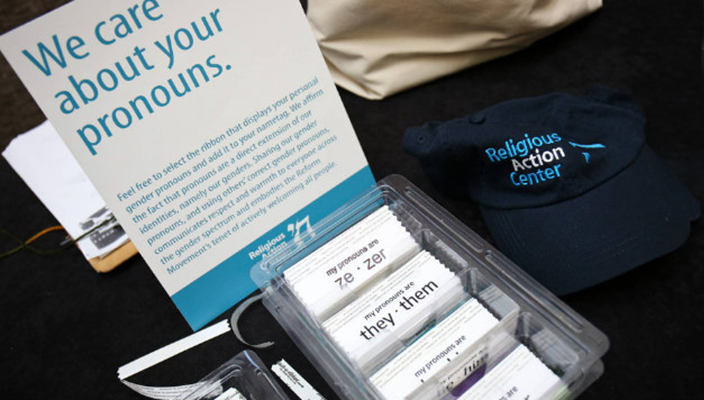
Communities of Belonging means recognizing the holiness of each individual and affirming and reflecting the actual diversity of Jewish people. The URJ is dedicated to representing individuals across the gender spectrum, including those transgender, nonbinary, and gender-expansive individuals. As stated in our 2015 Resolution on the Rights of Transgender and Gender Non-Conforming People*, we are committed to “the full equality, inclusion and acceptance of people of all gender identities and gender expressions,” part of our Jewish imperative to pursue justice (Deut. 16:18) and love our neighbors (Lev. 19:18). An important component of this involves respecting and using others’ pronouns. If you’re not sure about where to start, here are a few frequently asked questions about pronouns, their relation to gender, and how to properly use them.
*The term Gender Non-Conforming is now updated to a more inclusive term, Gender Expansive.
WHAT ARE THIRD-PERSON GENDER PRONOUNS?
Third-person gender pronouns are words that take the place of gendered nouns (i.e. “she/he/they”). For example, assuming Sarah uses they/them/theirs pronouns, we can say, "Sarah works at their job until 5:00."
WHY ARE PRONOUNS SO IMPORTANT?
Sadly, as found in the 2022 National Survey on LGBTQ Youth Mental Health by the Trevor Project, “nearly 1 in 5 transgender and nonbinary youth attempted suicide and LGBTQ Youth of color reported higher rates than their white peers. LGBTQ youth who felt high social support from their family reported attempting suicide at less than half the rate of those who felt low or moderate social support.” This means, when trans/non-binary individuals who are surrounded by people who affirm their gender, normalize pronoun usage, and use individuals’ correct pronouns, the impact can be lifesaving.
Pronouns are a direct extension of our identities, namely our genders. Referring to individuals with the correct pronouns is one of many ways we communicate respect and warmth to everyone across the gender spectrum. Stating your pronouns openly in your signature, on your online name, and in introductions(for example “I am Rachel, and I use the she/her/hers series, it’s nice to meet you.”) communicates your awareness of these topics and your dedication to respecting everyone’s identities. This is an important way to embody the Reform Movement’s tenet of actively affirming people from underrepresented backgrounds.
WHAT ARE SOME OF THE MOST COMMONLY USED THIRD-PERSON PRONOUNS?
The most commonly used pronouns are:
- she/her/hers (feminine, “she series”)
- he/him/his (masculine, “he series”)
- they/them/theirs (gender-inclusive, “they series”)
- ze/hir/hirs(or ze/zir/zirs) is another set of gender-inclusive pronouns
- Some individuals may even use pronouns that aren’t listed here or choose to not utilize pronouns altogether and use their name instead.
WHAT ARE SOME COMMON GENDER IDENTITIES I SHOULD KNOW?
Transgender (abbr. trans/trans*) is an umbrella term for anyone who knows themselves to be a gender that is different than the gender they were assigned at birth (pronoun usage varies, may utilize any of the pronouns).
Cisgender (abbr. cis) refers to a person who aligns with the gender they were assigned at birth (typically utilizes she series or he series).
Gender-Expansive refers to people whose gender expression does not align with societal expectations based on their perceived gender. Just because someone is gender-expansive does not mean that they are trans (pronoun usage varies, may utilize any of the pronouns).
Non-Binary refers to those who identify as a gender identity that specifically rejects the notion of binary gender (the idea that the only genders are “man” and “woman”) or who are not men or women exclusively. Can sometimes be used interchangeably with genderqueer (pronoun usage varies, may utilize any of the pronouns).
See a full list of terms from Keshet.
WHAT SHOULD I DO IF I ACCIDENTALLY MISGENDER SOMEONE (USE THEIR INCORRECT PRONOUN)?
If you inadvertently misgender someone, simply apologize, use the correct pronoun, and move on. For example: “I met her – sorry, them – at Shabbat last week.”
It’s important to remember not to profusely apologize or talk about how remembering pronouns are difficult for you, since it can make the person you misgendered feel obligated to console you. The best way to make up for it is by simply using the correct pronoun in the future.
WHAT IS JUDAISM’S VIEW ON THE GENDER SPECTRUM?
Judaism has acknowledged gender diversity since the days of the Mishnah and the Talmud. In fact, Jewish texts contain more than 1,600 references to individuals who exist outside of the gender binary.
Because Judaism is based on love and the pursuit of justice, we strongly believe it is our moral and ethical obligation to unconditionally care for everyone regardless of their gender identities and pronouns, for we are all made b’tzelem Elohim (in the image of God).
WHERE CAN I FIND MORE INFORMATION?
Here are a few additional resources from the Reform Movement:
- Review and use this Trans Inclusion Resource Guide from the URJ & Keshet.
- A Resource Manual for Promoting Transgender Belonging & Justice
- Read "Why Pronouns are So Important - and Why Using the Right Ones is So Jewish" on ReformJudaism.org.
- Create a pronoun name tag basket in your community and consider displaying this Printable Pronoun Resource next to it.
Explore Jewish Life and Get Inspired
Subscribe for Emails
